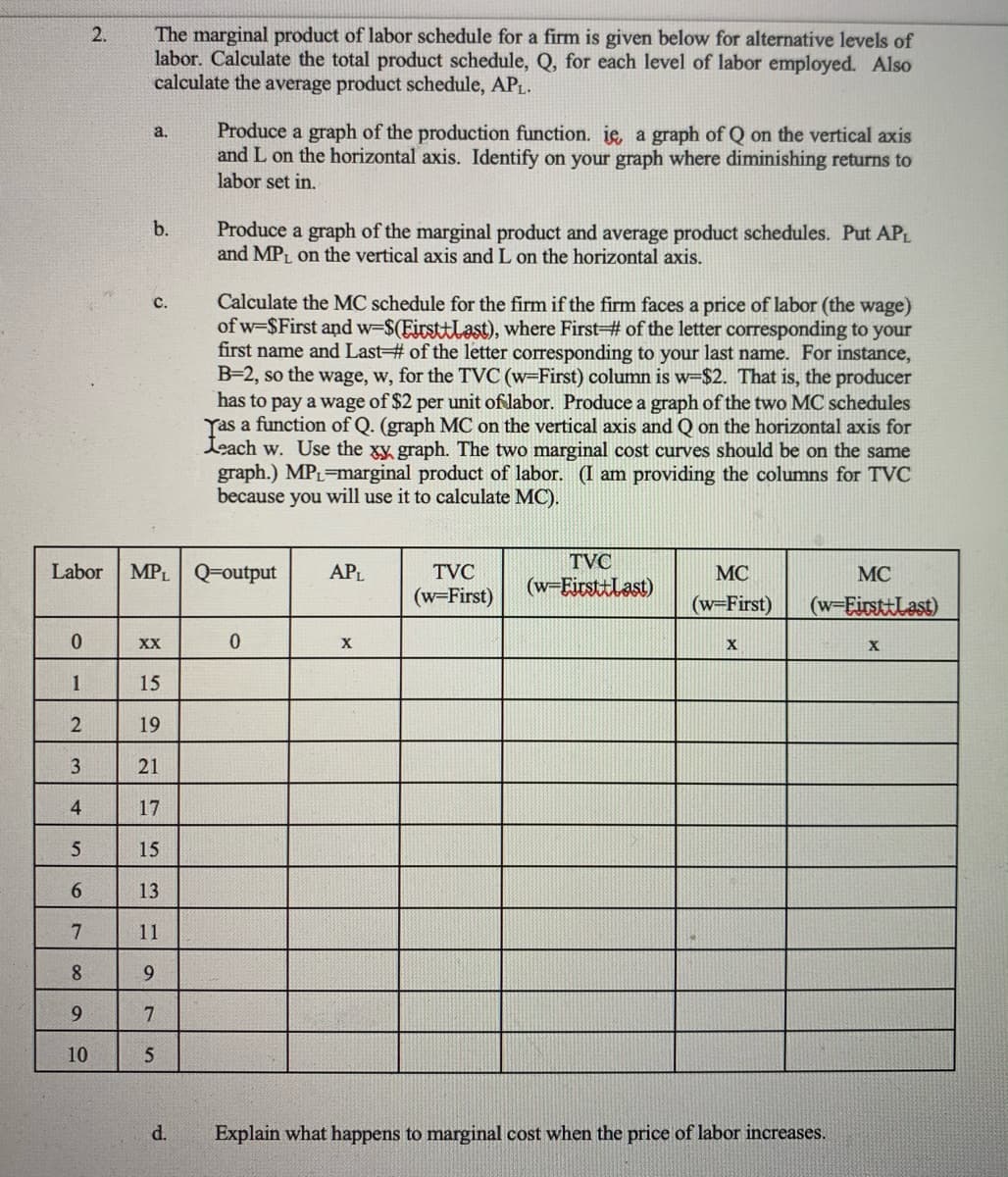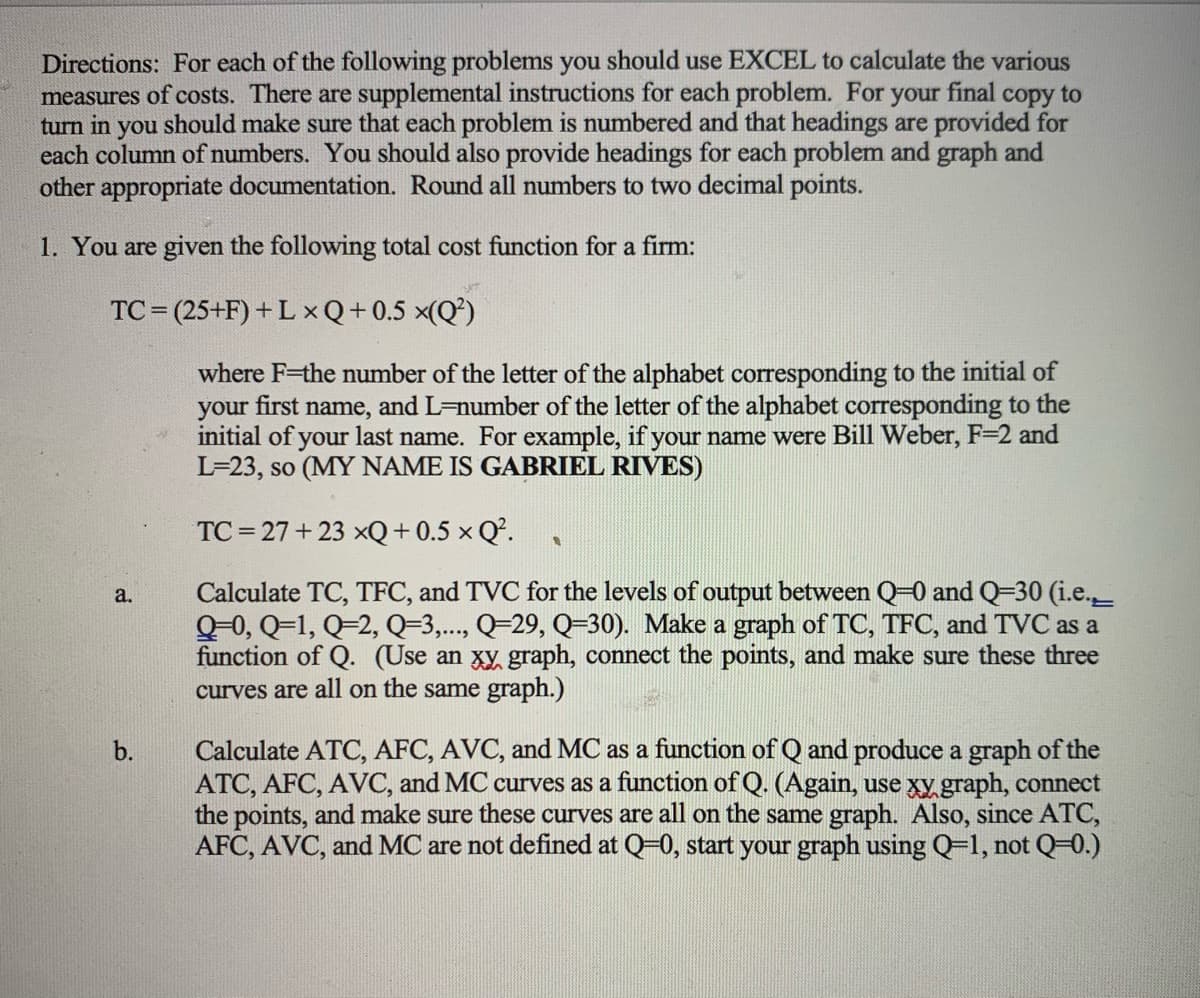The marginal product of labor schedule for a firm is given below for alternative levels of labor. Calculate the total product schedule, Q, for each level of labor employed. Also calculate the average product schedule, APL. Produce a graph of the production function. ie, a graph of Q on the vertical axis and L on the horizontal axis. Identify on your graph where diminishing returns to labor set in. a. b. Produce a graph of the marginal product and average product schedules. Put APL and MPL on the vertical axis and L on the horizontal axis. Calculate the MC schedule for the firm if the firm faces a price of labor (the wage) of w-$First and w-$(EirsttLast), where First-# of the letter corresponding to your first name and Last# of the letter corresponding to your last name. For instance, B=2, so the wage, w, for the TVC (w=First) column is w=$2. That is, the producer has to pay a wage of $2 per unit of labor. Produce a graph of the two MC schedules Tas a function of Q. (graph MC on the vertical axis and Q on the horizontal axis for с.
The marginal product of labor schedule for a firm is given below for alternative levels of labor. Calculate the total product schedule, Q, for each level of labor employed. Also calculate the average product schedule, APL. Produce a graph of the production function. ie, a graph of Q on the vertical axis and L on the horizontal axis. Identify on your graph where diminishing returns to labor set in. a. b. Produce a graph of the marginal product and average product schedules. Put APL and MPL on the vertical axis and L on the horizontal axis. Calculate the MC schedule for the firm if the firm faces a price of labor (the wage) of w-$First and w-$(EirsttLast), where First-# of the letter corresponding to your first name and Last# of the letter corresponding to your last name. For instance, B=2, so the wage, w, for the TVC (w=First) column is w=$2. That is, the producer has to pay a wage of $2 per unit of labor. Produce a graph of the two MC schedules Tas a function of Q. (graph MC on the vertical axis and Q on the horizontal axis for с.
Principles of Economics (MindTap Course List)
8th Edition
ISBN:9781305585126
Author:N. Gregory Mankiw
Publisher:N. Gregory Mankiw
Chapter14: Firms In Competitive Markets
Section: Chapter Questions
Problem 4PA
Related questions
Question
100%
Please do problem #2

Transcribed Image Text:The marginal product of labor schedule for a firm is given below for alternative levels of
labor. Calculate the total product schedule, Q, for each level of labor employed. Also
calculate the average product schedule, APL.
2.
Produce a graph of the production function. ie, a graph of Q on the vertical axis
and L on the horizontal axis. Identify on your graph where diminishing returns to
a.
labor set in.
b.
Produce a graph of the marginal product and average product schedules. Put APL
and MPL on the vertical axis and L on the horizontal axis.
Calculate the MC schedule for the firm if the firm faces a price of labor (the wage)
of w-$First and w-$(EirsttLast), where First# of the letter corresponding to your
first name and Last# of the letter corresponding to your last name. For instance,
B=2, so the wage, w, for the TVC (w=First) column is w=$2. That is, the producer
has to pay a wage of $2 per unit of labor. Produce a graph of the two MC schedules
Tas a function of Q. (graph MC on the vertical axis and Q on the horizontal axis for
Leach w. Use the xy graph. The two marginal cost curves should be on the same
graph.) MPL-marginal product of labor. (I am providing the columns for TVC
because you will use it to calculate MC).
с.
TVC
Labor
MPL Q=output
APL
TVC
MC
MC
(w-EirsttLast)
(w=First)
(w-First)
(w-EirsttLast)
XX
X
X
X
1
15
19
21
17
15
6.
13
7
11
8
9
d.
Explain what happens to marginal cost when the price of labor increases.
10
31

Transcribed Image Text:Directions: For each of the following problems you should use EXCEL to calculate the various
measures of costs. There are supplemental instructions for each problem. For your final copy to
turn in you should make sure that each problem is numbered and that headings are provided for
each column of numbers. You should also provide headings for each problem and graph and
other appropriate documentation. Round all numbers to two decimal points.
1. You are given the following total cost function for a firm:
TC = (25+F) +L xQ+0.5 x(Q²)
where F-the number of the letter of the alphabet corresponding to the initial of
your first name, and L-number of the letter of the alphabet corresponding to the
initial of your last name. For example, if your name were Bill Weber, F=2 and
L=23, so (MY NAME IS GABRIEL RIVES)
TC = 27+ 23 xQ+ 0.5 × Q.
Calculate TC, TFC, and TVC for the levels of output between Q-0 and Q=30 (i.e._
Q-0, Q=1, Q=2, Q=3,..., Q=29, Q=30). Make a graph of TC, TFC, and TVC as a
function of Q. (Use an xy graph, connect the points, and make sure these three
curves are all on the same graph.)
a.
Calculate ATC, AFC, AVC, and MC as a function of Q and produce a graph of the
ATC, AFC, AVC, and MC curves as a function ofQ. (Again, use xy.graph, connect
the points, and make sure these curves are all on the same graph. Also, since ATC,
AFC, AVC, and MC are not defined at Q-0, start your graph using Q=1, not Q=0.)
b.
Expert Solution
This question has been solved!
Explore an expertly crafted, step-by-step solution for a thorough understanding of key concepts.
This is a popular solution!
Trending now
This is a popular solution!
Step by step
Solved in 2 steps with 2 images

Knowledge Booster
Learn more about
Need a deep-dive on the concept behind this application? Look no further. Learn more about this topic, economics and related others by exploring similar questions and additional content below.Recommended textbooks for you

Principles of Economics (MindTap Course List)
Economics
ISBN:
9781305585126
Author:
N. Gregory Mankiw
Publisher:
Cengage Learning

Principles of Economics, 7th Edition (MindTap Cou…
Economics
ISBN:
9781285165875
Author:
N. Gregory Mankiw
Publisher:
Cengage Learning

Essentials of Economics (MindTap Course List)
Economics
ISBN:
9781337091992
Author:
N. Gregory Mankiw
Publisher:
Cengage Learning

Principles of Economics (MindTap Course List)
Economics
ISBN:
9781305585126
Author:
N. Gregory Mankiw
Publisher:
Cengage Learning

Principles of Economics, 7th Edition (MindTap Cou…
Economics
ISBN:
9781285165875
Author:
N. Gregory Mankiw
Publisher:
Cengage Learning

Essentials of Economics (MindTap Course List)
Economics
ISBN:
9781337091992
Author:
N. Gregory Mankiw
Publisher:
Cengage Learning

Exploring Economics
Economics
ISBN:
9781544336329
Author:
Robert L. Sexton
Publisher:
SAGE Publications, Inc

Managerial Economics: A Problem Solving Approach
Economics
ISBN:
9781337106665
Author:
Luke M. Froeb, Brian T. McCann, Michael R. Ward, Mike Shor
Publisher:
Cengage Learning
